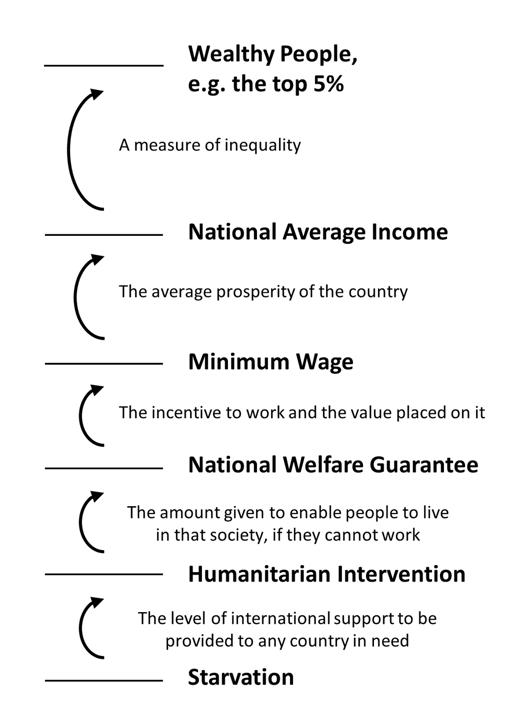6.7.2.3 Setting Intervention Policies for Inequality
The intervention policies for inequality differ according to the level of poverty being addressed and the level of political support
Incomes vary across a vast range, from those who are starving up to the mega-rich. The 6-layer model shown below is offered to provide clarity in defining objectives for policy interventions:
Intervention policies for inequality, which can be used to adjust the differentials between the above levels, are described below, starting from the bottom:
● A humanitarian intervention level might be defined as providing some of the basic requirements which are listed in Article 25 of the Universal Declaration of Human Rights, such as “food, clothing, housing and medical care” (Appendix 1). It can be seen as a moral imperative (4.3.5.1). An economic case can also be made for helping developing countries to become self-sufficient (3.5.8). The United Nations is a forum for negotiating the level at which aid should be given, and it can coordinate relief operations across the globe, but it currently needs to be supplemented by private charity and non-governmental organisations (NGOs).
● A national level of socio-economic entitlements for people who cannot work might be set somewhat higher than the humanitarian intervention level, if that country felt able to afford it. National entitlements are negotiated in the country’s political system (6.7.1.3) and must strike a balance between social need and taxpayer tolerance.
● Politicians set a level for a minimum wage. The amount by which the minimum wage exceeds the level of welfare benefits is a motivation to work, which is part of its economic impact (3.3.3.3), and it is also important politically – so that those in work don’t resent the level of benefits paid to those who don’t work.
● The national average income is, by definition, above the minimum wage. It depends upon a country’s economic performance, which in turn depends upon a country’s average productivity (3.3.3.1). As described previously, politicians have several ways of encouraging companies to invest in improving their productivity (6.7.1.4).
● The incomes of the wealthiest people tend to be very much higher than the average – a disparity which is increasing (3.5.6.2). Although it is tempting for politicians to try to ‘soak the rich’, there is a limit to how high tax rates can realistically go (3.2.4.6).
Politicians must recognise that people in wealthier countries need more money to maintain a sense of dignity than those in poor countries. Amartya Sen described what he termed “differences in relational perspectives” in The Idea of Justice (chap. 12, pp. 255-6). He also mentioned that Adam Smith had made the same point in the Wealth of Nations.
This page is intended to form part of Edition 4 of the Patterns of Power series of books. An archived copy of it is held at https://www.patternsofpower.org/edition04/6723.htm.
